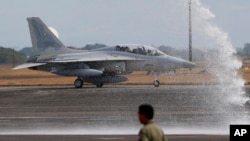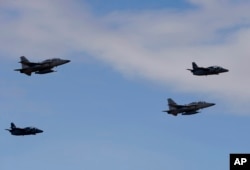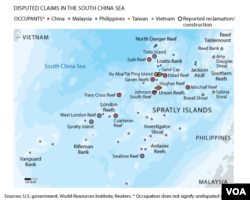The Philippines received two new fighter jets from South Korea Saturday, marking what the military calls a “return to the supersonic jet age.”
Philippine National Defense spokesman Peter Paul Galvez said “it’s only a small aircraft,” but it will help secure the country’s airspace from intrusions.
“Our pilots are excited. It’s a very welcome acquisition, increasing the, boosting the morale of our pilots in the Air Force,” Galvez said.
Ten years ago the Philippine Air force retired its 10 remaining F5 fighter jets, whose maintenance had grown costly.
First in decades
The purchase of the FA-50 trainer jets made by Korea Aerospace Industries Ltd. (KAI) is the first order for fighter aircraft in nearly four decades. (A lead-in fighter jet is a transitional craft flown mostly for training purposes ahead of flying a fully equipped fighter jet).
The FA-50 has night vision imaging good for night or day missions and can be outfitted with short-range missile-to-missile or air-to-ground missiles, among other combat features.
The jets are the first two aircraft to arrive from a total of 12 being acquired through 2017. The $420 million acquisition is part of the military’s five-year $1.8 billion upgrade program.
It is part of the Philippines plan to form a minimum credible defense posture in the face of China’s increasingly assertive stance in the South China Sea.
The Philippines military modernization plan is focused on supporting the armed forces shift from domestic to external security.
The country is boosting surveillance capabilities and maritime awareness activities amid Manila’s simmering dispute with Beijing over territory in the South China Sea.
Beijing has made artificial islands out of at least seven formations, most of which Manila claims. At least three of the manufactured islands have runways and harbors capable of accommodating military craft.
Claims on area
China says it has indisputable sovereignty over all of the South China Sea’s islands. Apart from the Philippines, Brunei, Malaysia, Taiwan and Vietnam also have competing claims in the resource-rich, heavily traveled sea.
Euan Graham, director of international security at the Sydney-based Lowy Institute said having the two new jets is “a start” toward building the minimum defense stance. He said it shows China that the Philippines is “finally” taking its “external defense seriously.”
“And in that broader calibration it will lend credence not just to the Philippines but also to the Philippines defense relations with its ally the United States and its growing relationship with other Southeast Asian countries including Vietnam,” Graham said.
The Philippines’ military budget is one of the smallest in Asia.
Next year’s budget includes $3.6 billion in military spending. That is a tiny fraction of China’s $145 billion military budget for 2015.












